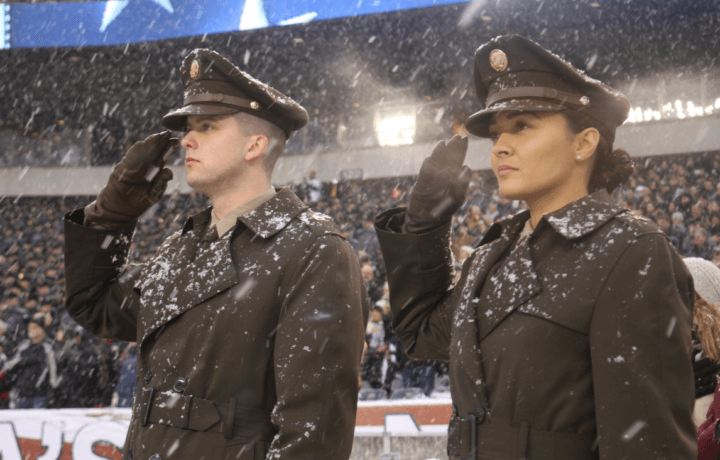The United States Space Force, the sixth and newest branch of the U.S. military, unveiled a prototype of its new dress uniform last fall. The dark blue uniforms were described as “futuristic” but were also met with comparisons to the “Imperial Navy” uniforms from Star Wars. The U.S. Army on the other hand has adopted a new uniform that is a throwback to another war, but one from our actual history.
And instead of resembling anything from a long time ago in a galaxy far, far away – the Army’s adopted pinks and greens that were worn by the Greatest Generation during the Second World War. It was actually a year ago that the Army rolled out its long-awaited update to its uniform wear guidelines. The revised AR 670-1 had last been updated in 2017.
Soldiers began wearing the Army Green Service Uniform (AGSU) after senior leaders approved it for everyday wear in late 2018, when it officially replaced the blue Army Service Uniform (ASU). Soldiers will still have until Oct. 1, 2027 to purchase the AGSU, after which the ASU will become the Army’s optional dress uniform.
Got It Right
Trainees at Fort Jackson, SC – the Army’s largest basic training base – have been among the first recruits to receive the throwback uniforms. That included the 2nd Battalion, 13th Infantry Regiment’s trainees who were fitted for the AGSU in October.
“We got it right this time,” Fort Jackson Command Sgt. Maj. Philson Tavernier said via a statement to The Post and Courier newspaper. “The AGSU is distinctive and epitomizes the United States Army. This is my third dress uniform, and I would say they are the most practical and best-looking. It is an iconic uniform that brings us back to our roots.”
The uniform was dubbed “pink and greens” by service members in 1940s as the pair of pants often had a pink hue. The new uniform consists of a green jacket, khaki (not actually pink) pants, a khaki dress shirt and brown oxford shoes. In addition, soldiers are now supplied matching socks, a tie and garrison cap, the flat and straight-sided foldable hat.
Army recruiters and drill sergeants had been among the very first soldiers to receive the uniforms in late 2020, as they were typically considered the face of the Army. Fort Sill, OK, had been the very first training location to issue the AGSU, followed by Fort Leonard Wood, MO, and then Fort Benning, GA.
Ending the “Pink Tax” For Women
Another update from last year when Sens. Maggie Hassan, D-N.H., and Joni Ernst, R-Iowa, aimed to eliminate the so-called “pink tax,” or the higher costs of female uniforms compared to male uniforms.
“It is absurd that we are forcing service members to fork over thousands of dollars in order to pay for necessary clothing items that they wear while serving our country,” Hassan said in a statement in October when introducing the bill. “This disparity in uniform costs is particularly stark for women, who are in some cases paying almost twice as much for the same uniform item as their male counterparts.”
The Senate bill, officially the Military Forces Assuring that Treatment of Items by Gender are Uniform and Equal across the Services (FATIGUES) Act, called for the Pentagon to review any changes to uniforms for potential differences in out-of-pocket costs between genders, and would further mandate a report on the retail costs of items for male and female officers and enlisted personnel. The bill was introduced after the nonpartisan Government Accountability Office (GAO) earlier last year confirmed that female service members face higher out-of-pocket costs for uniform items than their male counterparts.
Female members of the military typically face higher out-of-pocket costs to replace uniform items because articles that are not considered “uniquely military” – and so can’t be paid for with the clothing allowance, such as underwear – generally cost more for women than men, according to the GAO report.
In addition, enlisted service members receive a uniform when they enter the military and an annual clothing allowance after that to replace items. However, officers generally receive a $400 clothing allowance when they first report for active duty, yet do not receive an annual stipend for replacements. The Army had previously estimated its new Army Green Service Uniform dress coat would cost about $163 for enlisted women and $82 for enlisted men.
The FATIGUES Act has been referred to the Committee on Armed Services.
New “Ike Jacket”
Soldiers will also be able to purchase “add-ons” for the uniform, including the “Ike” jacket, which was based on the cropped coat made famous by Gen. Dwight Eisenhower during the Second World War. It had been intended to be worn on its own or as an insulating layer beneath the M1-943 Field Jacket, and over the standard wool flannel shirt and wool sweater.
Eisenhower had been impressed by the waist-cropped style jacket that was first worn by Maj. Gen. Ira C. Eaker of VII Bomber Command in England. Eaker had modeled the jacket after the standard British “battledress” uniform worn during the World War II. Eaker reportedly gave his jacket to Eisenhower, who had similar jackets produced for wear in Europe.




